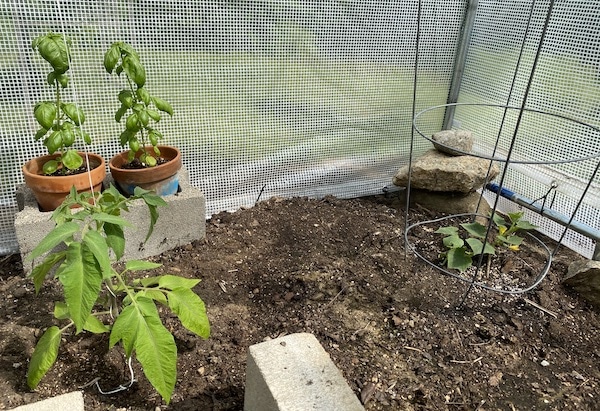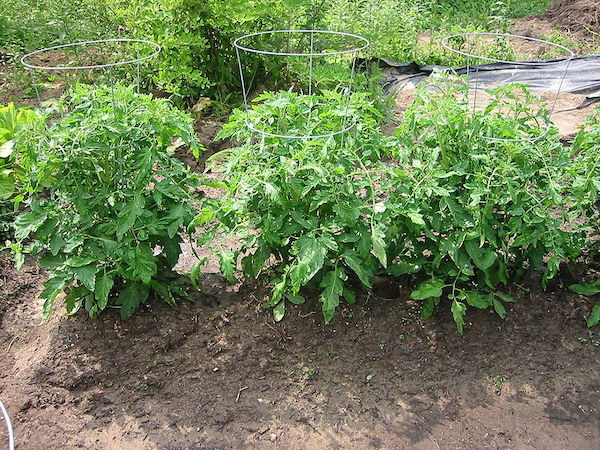Updated: July 19, 2022
Proper vegetable plant spacing isn’t as simple as many others would have you believe. It depends on a combination of factors. You can use a standard rule of thumb for each plant and probably get good results.
However, if you want to get the best possible results, you should first consider the:
- Type of plant you will grow (of course)
- Amount of water you can provide
- Level of fertility in your soil
If this disappoints you because you were looking for a handy chart with spacing distances for each type of plant, you can see my vegetable plant spacing chart below. But if you really want to get the best spacing, it’s more complicated than a simple chart.
Let’s take a sec to get the legal words out of the way. This article may contain affiliate links. That means if you click and buy from my partners, I will make a tiny amount of money at no cost to you. This in no way affects my recommendations.
My vegetable plant spacing mistake
A vegetable plant spacing mistake that I’ve made repeatedly is leaving too little space between plants. One reason for this is I’m always tempted to try and get more out of my limited growing area.
But it’s also due to the influence of Square Foot Gardening, a gardening system made popular by Mel Bartholomew.
Square Foot Gardening (SFG) is a raised bed system where the growing area is divided into one foot boxes. It requires that you plant your vegetables closely packed together because at least one plant is grown in each box.
The premise of SFG is that by packing plants closely together you need less space and also less water. By reducing the area that you need to water, you will use less. Plus, dense plantings shade out water sucking weeds and stop the sun from drying out your soil.
SFG is appealing because it makes growing vegetables simple and orderly. It promises that you can work less and get more out of their garden.
Does Square Foot Gardening Work?
But SFG doesn’t always work. Sometimes plants need to have some room for root growth.
It wasn’t until I read Carol Deppe’s The Resilient Gardner that I realized that Square Foot Gardening could only work under ideal conditions.
SFG calls for a growing medium with equal parts of high quality compost, peat moss and vermiculate. Any soil that is one-third compost is nutrient rich and will hold moisture exceptionally well. SFG only works because of the extreme high fertility and water holding capacity of the soil. Not everyone is able to always use soil that is perfect.
In her book, Deppe points out that more vegetable plant spacing can help make up for less than ideal soil or moisture. When roots have space to expand without competition, you can sometimes get away with fewer soil amendments and less watering.
Of course, weeding also reduces competition between plants too, so you must keep the area weed free in order to get the advantages of additional spacing.
50 pounds of tomatoes
Cody Witt at the Real Deal Compost blog has had as much as 50 pounds of tomatoes from one plant. As you might expect from someone with a blog on composting, he includes plenty of compost as part of his soil.
He also uses Walls-of-Water to get an early start with his plants. But when it comes to plant spacing, you can see from this photo of his tomato plants, Witt gives them plenty of room.
So I’m not the only one who believes in giving plants lots of space.
My plant spacing mistakes
Below I have five examples of where I wish I had given my plants more space. I think you’ll find that these are common situations. I bet you’ll recognize at least one in your garden.
1. Winter sowing arugula. I put far too many arugula seeds in my winter sowing containers because I thought the germination rate would be lower in the cold.
It turned out that almost every seed germinated. They were so tightly packed that it was hard to thin them and the health of the plants suffered in spite of the rich potting soil.
2. Cucumber seedlings. In the past, I’ve planted cucumber seedlings three-to-a-paper-pot because this is the way nurseries do it. I didn’t realize that I should let only the strongest vine grow and cut the rest.
My standard practice was to plant all three together, so the plants competed against each for moisture and nutrients as their roots took hold. Next year, I will leave only one vine per pot (and plant more pots).
3. Cut and come again lettuce. The package of mixed leaf lettuce clearly says thin to eight inches apart when the lettuce is two inches tall. This fall I’m going to be ruthless and make sure I adhere to this guideline.
4. Tomatoes. Against my better judgment, I listened to my wife and planted tomato seedlings two feet apart in raised beds. I can see now that I should have planted them at least three feet apart, even if that meant having fewer plants.
The soil in my beds is good, but not good enough to plant them only two feet apart. Plus, they would benefit from increased air flow and sun penetration.
5. Basil seedlings. I did a test where I planted a paper pot with a single basil seedling in one location and another paper pot with multiple seedlings in another location. My estimate is that the single seedling produced about five times the volume of leaves as all of the others combined!
Hoop House Tomatoes
When growing tomatoes in a hoop house, plant spacing is more about keeping good air flow than fertility and moisture. That’s because hoop house plants can grow their roots into the ground outside of the hoop house. This gives them plenty of root space.
Airflow, however, becomes more critical because you want to avoid fungal diseases and keep the temperature down in warm weather. So spacing and pruning are important.

Vegetable Plant Spacing Chart
If you want a rough guide to start to determine the spacing for your plant, here it is. You can use this as a starting point and then take an educated guess on how to adjust by considering soil fertility and access to water.
| Plant | Between Plants | Between Rows |
| Artichokes | 18″ | 24 – 36″ |
| Asparagus | 12 -18″ | 60″ |
| Beans – Bush | 2 – 4″ | 18 – 24″ |
| Beans – Pole | 4 – 6″ | 30 – 36″ |
| Beets | 3 – 4″ | 12 – 18″ |
| Black Eyed Peas | 2 – 4″ | 30 -36″ |
| Broccoli | 18 – 24″ | 36 – 40″ |
| Broccoli Rabe | 1 – 3″ | 18 – 36″ |
| Brussel Sprouts | 24″ | 24 – 36″ |
| Cabbage | 9 – 12″ | 36 – 44″ |
| Carrots | 1 – 2″ | 12 – 18″ |
| Cauliflower | 18 – 24″ | 18 – 24″ |
| Celery | 12 – 18″ | 24″ |
| Corn | 10 – 15″ | 36 – 42″ |
| Cucumbers – Trellis | 2 – 3″ | 30″ |
| Eggplants | 18 – 24″ | 30 – 36″ |
| Kale | 12 – 18″ | 24″ |
| Leeks | 4 – 6″ | 8 – 16″ |
| Lentils | .5 – 1″ | 6 – 12″ |
| Lettuce – Head | 12″ | 12″ |
| Lettuce – Leaf | 1 – 3″ | 1 – 3″ |
| Okra | 12 – 15″ | 36 – 42″ |
| Onions | 4 – 6″ | 4 – 6″ |
| Parsnips | 8 – 10″ | 18 – 24″ |
| Peas | 1 – 2″ | 18 – 24″ |
| Peppers | 14 – 18″ | 18 – 24″ |
| Potatoes | 8 – 12″ | 30 – 36″ |
| Pumpkins | 60 – 72″ | 120 – 180″ |
| Radicchio | 8 – 10″ | 12″ |
| Radishes | .5 – 4″ | 2 – 4″ |
| Shallots | 6 – 8″ | 6 – 8″ |
| Spinach – Mature | 2 – 4″ | 12 – 18″ |
| Spinach – Baby | .5 – 1″ | 12 – 18″ |
| Squash – Summer | 18 – 28″ | 36 – 48″ |
| Squash – Winter | 24 – 36″ | 48 – 60″ |
| Sweet Potatoes | 12 – 18″ | 36 – 48″ |
| Swish Chard | 6 – 12″ | 12 – 18″ |
| Tomatoes | 24 – 36″ | 48 – 60″ |
| Turnips | 2 – 4″ | 12 – 18″ |
| Zucchini | 24 – 36″ | 36 – 48″ |
One more piece of evidence: This year, I had much stronger potato, beet and carrot crops, in spite of the voles. I attribute this to more rigorous thinning of the beets and carrots and more space between the seed potatoes.
If you’ve had luck grouping plants more closely together (or not), let us know by commenting below. I’d love to hear your experiences.
Related articles:
- Vegetable Garden Watering Tips
- Should You Mulching Raised Garden Beds?
- The Importance of Hardening Off Seedlings
Suburban Hobby Farmer is a participant in the Amazon Services LLC Associates Program, an affiliate advertising program designed to provide a means for sites to earn advertising fees by advertising and linking to amazon.com.
